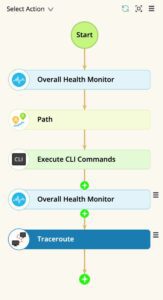
No-code, high value: Democratizing Automation for Better Network Operations
You may have noticed that low-code and no-code technologies are taking enterprise IT by storm. Speaking to TechTarget, Forrester analyst John Bratincevic reported that up to 75% of enterprises will make low-code technology a part of their software strategies by 2024. This explosive adoption is the result of a perfect storm of events:
- A dramatic rise in the awareness and availability of no-code/low-code platforms (tools that allow users to design applications through visual drag-and-drop templates without requiring programming knowledge)
- Enterprises are feeling the compounding effects of an ongoing talent shortage, especially when it comes to hiring and retaining trained developers
- “The Great Resignation” is hitting the tech industry and further exacerbating the talent shortage
- The demands of Digital Transformation continue to grow unabated, especially in the face of a world that increasingly depends on the network to work and live
No-code/low-code technologies are also growing in adoption because they are generating results. According to No-Code Census 2020, users choose no-code solutions because they are 4-5x faster, easier and more affordable than traditional solutions. While increasingly ubiquitous in areas such as business application development and website design, no-code tools are not commonly used in the enterprise network. However, networking teams are also feeling the pain of current labor and talent trends. Search for “network engineer” on any job posting board and you will likely see an abundance of openings with competitive wages and benefits.
We can think of the network is the backbone of digital business. Think about your experiences with the business you rely on. Do you interact with them through tools such as mobile applications and digital payments? If yes, then a high-performing network is critical to your experience as a customer. In ways seen and unseen, the network is becoming the most critical piece for enabling digital business, especially in our socially distanced reality. It is my view that because of these demands on the network and the proven efficiencies of no-code technologies, it is time for no-code solution development to arrive in enterprise network operations.
The way no-code solutions enable results for network operations is through the democratization of automation. For many years, knowledge of coding languages and CLI has been concentrated within a small number of people within each organization, creating a chokepoint to scaling network automation. A lot of the time, these experts are bogged down with level 1 tasks that could easily be passed down to junior associates if no-code tools were available. Additionally, when subject-matter experts leave the company, they often create a vacuum of functional knowledge that can lead to problems with outages as troubleshooting and maintenance tasks become harder to quickly address. In turn, this leads to a degradation of core business operations, negatively affecting outcomes for customers and employees.
This shortage of skilled developers will not end anytime soon. According to 2021 data from the US Bureau of Labor Statistics, the number of software developer positions will grow at 22% between 2020-2030. In the last several years, multiple studies have pointed to a growing gap between the number of developer and related job openings and trained resources to fill them. A 2020 EMA survey of network managers suggests that these shortages have hit networking teams, with 31% of respondents citing a shortage of network management talent as a challenge.
The labor shortage won’t be solved overnight. However, there is a way forward – one that leverages the people you have and gives them new skills and capabilities. Given how dependent we all are on the “always-on” network, it becomes imperative to empower the people you have with no-code tools for rapid problem resolution, necessary operational tasks, and proactive outage prevention. Manual coding of network operations processes comes with inherent bottlenecks, even with a team of trained developers.
Automation is what drives scalability allowing you to better meet ever-rising demands for network availability and performance by reducing the network discovery and remediation burden on your network engineers. These remediation steps can be captured in automated and recorded Runbooks to allow for broader use by your network operations team thereby maximizing productivity.
In my view, a comprehensive no-code network automation platform captures your team’s knowledge for the long haul. Losing a team member no longer means sleepless nights over the loss of their knowledge about how to keep the network running smoothly. With a no-code platform, their knowledge is enshrined and passed down in perpetuity, helping future employees come up to speed quickly. Not only that, but you can leverage no-code automation proactively with intent-based network management to eliminate time spent on the steps for how tasks are done. Similarly, when processes change, no-code development means those changes can be captured modularly, without requiring the painful and error-prone motion of rolling back and rewriting code.
Simply put, we firmly believe that no-code automation will play an outsized role in the future with network operations. To learn more about this topic, attend NetBrain’s proof-of-concept session at ONUG Fall 2021: No-Code Network Operations Automation for Future-Oriented Hybrid Networks.

Image: No-Code Executable Runbook



